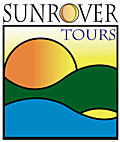
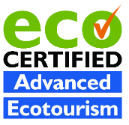


BOOK ONLINE NOW! or PHONE: 07 3203 4241 - No credit card fees!
*** Gift Vouchers ***
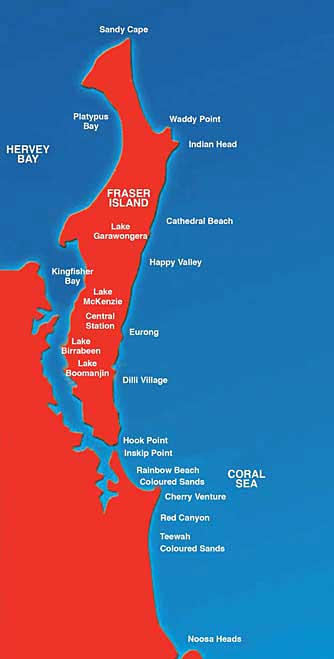
Fraser Island (K'Gari) is an island located along the southern coast of Queensland, Australia, approximately 200 kilometres north of Brisbane. Its length is about 120 kilometres and its width is approximately 24 kilometres. It was inscribed as a World Heritage site in 1992. The island is considered to be the largest sand island in the world at 1840 km². It is also Queensland's largest island, Australia's sixth largest island and the largest island on the East Coast of Australia.
The island has rainforests, eucalyptus woodland, mangrove forests, wallum and peat swamps, sand dunes and coastal heaths. It is made up of sand that has been accumulating for approximately 750,000 years on volcanic bedrock that provides a natural catchment for the sediment which is carried on a strong offshore current northwards along the coast. Unlike many sand dunes, plant life is abundant due to the naturally occurring mycorrhizal fungi present in the sand, which release nutrients in a form that can be absorbed by the plants. Fraser Island is home to a small number of mammal species, as well as a diverse range of birds, reptiles and amphibians, including the occasional saltwater crocodile. The island is part of the Fraser Coast Region and protected in the Great Sandy National Park.
Fraser Island (K'Gari) has been inhabited by humans for as much as 5,000 years. Explorer James Cook sailed by the island in May 1770. Matthew Flinders landed near the most northern point of the island in 1802. For a short period the island was known as Great Sandy Island. The island became known as Fraser due to the stories of a shipwreck survivor named Eliza Fraser. Today the island is a popular tourism destination. Its resident human population was 360 at the census of 2006.
Fraser Island (K'Gari) is separated from the mainland by Great Sandy Strait. The southern tip, near Tin Can Bay, is situated to the north of Inskip Peninsula. The most northern point of the island is Sandy Cape where the Sandy Cape Light operated from 1870 to 1994. The establishment of the lighthouse was the first permanent European settlement on the island. The bay on the north east coast is called Marloo Bay and on the north west coast is Platypus Bay. The most westerly place on the island is Moon Point.
Eli Creek is the largest creek on the east coast of the island with a flow of 80 million litres per day. Eli Creek has its own unique and varied wild life. Coongul Creek on the west coast has a flow rate of four to five million litres per hour. Some of the swamps on the island are fens, particularly near Moon Point. This was only discovered in 1996 when a group of experts who had attended a Ramsar conference in Brisbane flew over the island and conducted an aerial survey. From above they noticed the distinct patterns of potholed peat which are devoid of trees. This was the first instance of fens found in Australia and in a sub-tropical region, although more were subsequently found on the adjacent Cooloola coast.
The total volume of sand above sea level on Fraser Island is 113 cubic kilometres (27 cubic miles).All of the sand, which originated in the Hawkesbury, Hunter and Clarence River catchments in New South Wales has been transported north by longshore transport. Along the eastern coast of the island the process is removing more sand than it is depositing, resulting in the slow erosion of beaches which may accelerate with sea level rises attributed to climate change. The sand consists of 98% quartz.
All hills on the island have been formed by sandblowing. Sandblows are parabolic dunes which move across the island via the wind and are devoid of vegetation. In 2004, there was an estimated total of 36 sandblows on the island. With year-round south-easterly wind, the sand dunes on the island move at the rate of 1 to 2 meters a year and grow to a height of 244 meters. The dune movement creates overlapping dunes and sometimes intersect waterways and covers forests. Dune-building has occurred in episodes as the sea levels have changed and once extended much further to the east. The oldest dune system has been dated at 700,000 years, which is the world's oldest recorded sequence.
The coloured sands found at Rainbow Gorge, The Cathedrals, The Pinnacles and Red Canyon are examples of where the sand has been stained over thousands of years due to the sand conglomerating with clay. Hematite, the mineral pigment responsible for the staining acts like cement. This allow the steeper cliffs of coloured sand to form. Coffee rock, so-called because when it is dissolved in water it turns the colour of coffee, is found in outcrops along the beaches on both sides of the island.
The 120 kilometres beach runs along most of the east coast of Fraser Island. It is used as a landing strip for planes and an informal highway for vehicles (highway rules state that vehicles must give way to aircraft if they are oncoming). Along the beach are the Champagne Pools, Indian Head, the Maheno Wreck and the outflow of Eli Creek. Exposed volcanic rocks are found at Indian Head, Waddy Point and Middle Rocks as well as near Boon Boon Creek.
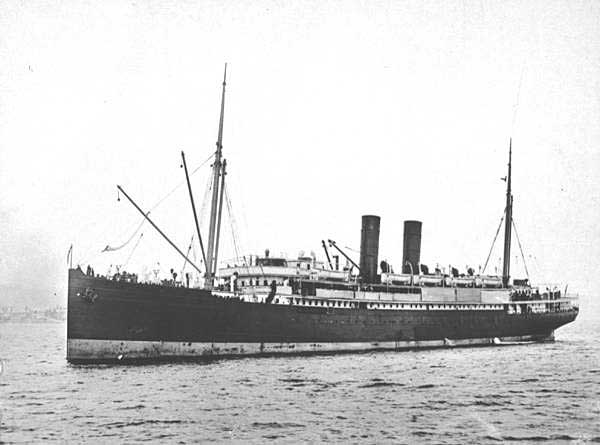
A major landmark of Fraser Island (K'Gari) is the shipwreck of the S.S. Maheno. The S.S. Maheno was originally built in 1905 in Scotland as a luxury passenger ship for trans-Tasman crossings. During the First World War the ship served as a hospital ship in the English Channel, before returning to a luxury liner. In 1935, the ship was declared outdated and on 25 June 1935 the ship was being towed from Melbourne when it was caught in a strong cyclone. A few days later, on 9 July 1935 she drifted ashore and was beached on Fraser Island. During the Second World War the Maheno served as target bombing practice for the RAAF and was used as an explosives demolition target by special forces from the Fraser Commando School. The ship has since become severely rusted, with almost three and a half storeys buried under the sand. Climbing on the shipwreck is not permitted.
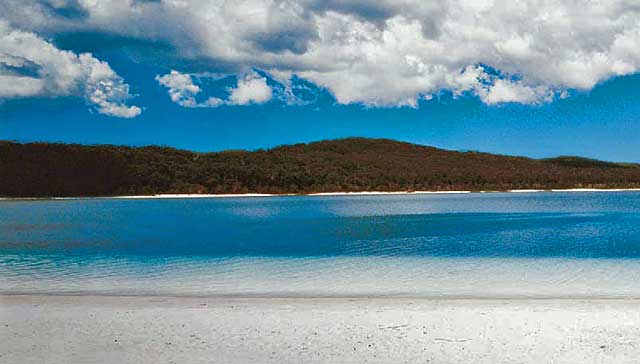
Fraser Island has over 100 freshwater lakes,as well as the second highest concentration of lakes in Australia after Tasmania. The freshwater lakes on Fraser Island are some of the cleanest lakes in the world. A popular tourist area is Lake McKenzie which is located inland from the small town of Eurong. It is a perched lake sitting on top of compact sand and vegetable matter 100 metres above sea level. Lake McKenzie has an area of 150 hectares and is just over 5 metres in depth. The beach sand of Lake McKenzie is nearly pure silica. The lakes have very few nutrients and pH varies, though sunscreen and soaps are a problem as a form of pollution. Freshwater on the island may become stained by organic acids found in decaying vegetation. Because of the organic acids a ph level of 3.7 has been measured in some of the island's perched lakes. The high acidity levels prevent many species from finding habitat in the lakes.
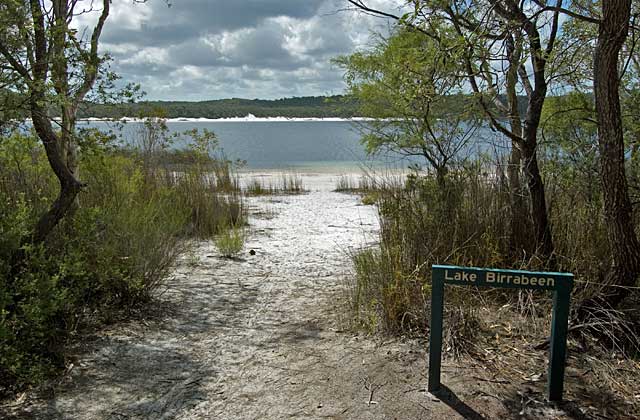
Another perched lake on the island is Lake Boomanjin, which at 200 hectares in size, is the largest perched lake in the world. In total there are 40 perched lakes on the island, half of all known lakes of this kind on the planet. Lake Boomanjin is feed by two creeks that pass through a wallum swamp where it collects tannins which tint the water red. Lake Wabby is the deepest lake on the island, at 12 metres (39 ft) in depth and also the least acidic which means it has the most aquatic life of all the lakes.
Some of the lakes on Fraser Island are window lakes. These form when the water table has risen to a point higher than the surrounding land. Most of the valleys on the islands have creeks which are fed by springs. Motor boats and jet skis are banned from the island's lakes.
Estimates of the number of mammal species present on the island range from 25 to 48. Mammals found on Fraser Island (K'Gari) include swamp wallabies, echidnas, ringtail and brushtail possums, sugar gliders, squirrel gliders, phascogales, bandicoots, potoroos, flying foxes and dingoes. The Swamp Wallaby finds protection from dingos in the swampy areas which have dense undergrowth. There are 19 species of bats which live on or visit Fraser Island.
Until 2003, when they were removed by the Environmental Protection Agency,there were a few brumbies (horses) on the island, descendants of Arab stock turned loose for breeding purposes, and joined in 1879 by horses brought over for the logging industry.

Dingoes were once common on the island, but are now decreasing. The Fraser Island (K'Gari) dingoes are reputedly some of the last remaining pure dingoes in Eastern Australia and to prevent cross-breeding, dogs are not allowed on the island. According to DNA-examinations from the year 2004, the dingoes on Fraser Island are "pure". However, skull measurements from the 1990s detected crossbreeds between dingoes and domestic dogs among the population.
Up until 1995, there were no official records of dingoes attacking humans on Fraser Island. In April 2001, a boy named Clinton Gage wandered away from his family and was discovered dead, with indications of a dingo mauling. Over 120 dingoes were killed by rangers as a result of the incident, though locals believe the number was much greater. After the 2001 attack, four dedicated rangers were allocated dingo management roles and ranger patrols were increased. There are fines for feeding dingoes or leaving food and rubbish out which may attract them.
As of January 2008, the number of dingoes on the island was estimated to be 120 to 150, and sightings have become less common. A University of Queensland researcher, Nick Baker, claims the dingoes on Fraser Island have adopted unusual behaviour. Rather than hunt in small packs, Fraser Island dingoes had developed a tolerance for each other and work together in one big hunting pack. Dingo-proof fences, consisting of metals bars across a concrete pit and a 1.8 m high mesh fence were built around nine island settlements in 2008, to keep the dingos out of the townships.
In late 2009, a former ranger on the island, Ray Revill, claimed 70% of the dingo population, which was then estimated at between 100 and 120 animals, was malnourished. In March 2010, three separate reports of dingos biting tourists were made. Backpackers have been criticised for ignoring advice from park rangers as they try to provoke reactions from dingoes while taking photographs.

There has been a total of 74 different species of reptiles recorded on Fraser Island. 18 species of snakes have been identified with one third of them considered dangerous. Goannas, snakes, geckos, skinks and frogs are all present on the island. Some frog species have evolved to cope with the acidic waters of lakes and swamps on the island, and are appropriately called acid frogs. The island is home to the recently discovered Fraser Island sand skink. Freshwater turtles such as Kreffts river turtle are found in the island's lakes and creeks.
Saltwater crocodiles are exclusively tropical reptiles and usually found in Far North Queensland (several hundred kilometres north-west of Fraser Island,) however, occasionally during the warmer season (December through March, when water temperatures reach consistent tropical temperatures) crocodiles may appear in areas in and around Fraser Island. This is very rare, but during the 2008-2009 summer season at least four crocodiles (one over 4 metres in length) were present. It is thought that these reptiles are seasonal visitors, as they always disappear during the cold months (presumably returning to tropical northern Queensland.) This sort of activity was apparently reported but unverified decades ago (a handful of crocodiles have also historically been observed on very rare occurrences around Brisbane, the Gold Coast and Sunshine Coasts during the warmer season) but within recent years has been proven and observed more often. Crocodiles do not breed nor do they appear to have any permanent populations living on Fraser Island.
Fraser Island forms part of the Cooloola and Fraser Coast Important Bird Area (IBA). There are over 350 different species of birds on the island.[5] Birds of prey include sea eagles, peregrine falcon, osprey and kites. Other common birds include pelicans, terns, honeyeaters, gulls, kingfishers, kookaburra, owls, doves, thornbills, ducks, brolgas, and cockatoos. The island is visited by 20 species of migratory wader birds from as far afield as Siberia. There are 22 different species of gulls and terns, four species of falcons and six species of kingfishers. A rare, bird on the island is the Eastern Ground Parrot, already extinct in some parts of Australia.
Cetaceans, such as Humpback Whales and some species of dolphins are frequent visitors to the area. Dugongs and tiger Sharks can also be found in surrounding waters. Mud crabs are found on the western side of the island near mangrove-lined estuaries. 24 freshwater fish species are found in the island's lakes.
There has been 300 species of ants recorded on Fraser Island. Long finned eels and giant earthworms are also found on the island.
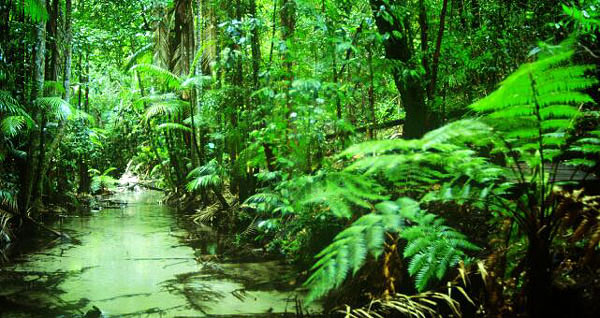
The flora of Fraser Island (K'Gari) is unique and diverse. More than 865 species of plants thrive on the island. It is the only place on Earth where tall rainforest grows in sand. The island contains the largest extent of wallum heath remnants in Queensland. In Pile Valley, 1,000 year old rough-barked satinays are found. Despite being logged the kauri pines dominate in some areas. Scribbly gums, red gums, piccabeen palms, Blue Quandong, brush box and pandanus all grow on Fraser Island. Along the coast, the foredunes are dominated by salt-tolerant species which includes pigface, goats foot vine and beach spinifix. Spinifix sericeus is an important foundation species. Decayed matter from this dune grass breaks down in the sand, providing vital nutrients for other plant species, such as the Beach Oak. The rare Angiopteris evecta, a species of fern that has the largest fronds in the world, grows on Fraser Island. The southwest coast is dominated by mangroves.
As one travels from east to west across the island, the dune age increases. These leads to the progressive maturing of vegetation in the same direction, except for some areas along the western coast where soil leaching has decreased the nutrient soil layer to a depth beyond the reach of plant roots. Each lake on Fraser Island is surrounded by concentric vegetation zones. Typically these zones range from rushes in the shallows, then a mix of pioneer species on the beaches, through to sedges, heath, paperbarks, shrubs and finally eucalypt or banksia woodlands.
The earliest known name of the island is 'K'gari' in the Butchulla people's language (pronounced 'Gurri'). It means paradise.
According to Aboriginal legend, when humans were created and needed a place to live, the mighty god Beiral sent his messenger Yendingie with the goddess K'gari down from heaven to create the land and mountains, rivers and sea. K'gari fell in love with the earth's beauty and did not want to leave it. So Yendingie changed her into a heavenly island - Fraser Island.
The name Fraser Island (K'Gari) comes from Eliza Fraser and her story of survival from a shipwreck on the island. Captain James Fraser and his wife, Eliza Fraser, were shipwrecked on the island in 1836. Their ship, the Stirling Castle, set sail from Sydney to Singapore with 18 crew and passengers. The ship was holed on coral while travelling through the Great Barrier Reef north of the island. Transferring to two lifeboats, the crew set a course south, attempting to reach the settlement at Moreton (now Brisbane). During this trip in the lifeboats, Captain Fraser's pregnant wife gave birth in the leaking lifeboat. The infant died soon after birth. The Captain's lifeboat was becoming more and more unseaworthy and was soon left behind by the other lifeboat which continued on. The sinking boat and its crew was beached on what was then known as the Great Sandy Island. Whether the survivors died due to disease, hunger, exhaustion or battles with the native population will never be known for sure; most likely a little of all of the above. Captain Fraser died leaving Eliza living among the local peoples. She was rescued 6 weeks after being shipwrecked by a convict, John Graham, who had lived in the bush as an escapee, and who spoke the Aboriginal language. He was sent from the settlement at Moreton by the authorities there who had heard about Eliza' plight, and negotiated her return. Within 6 months, Eliza had married another sea captain. She moved to England and became a sideshow attraction in Hyde Park telling ever more lurid tales about her experiences with white slavery, cannibalism, torture and murder. As she is known to have told several versions of the story, it is unknown which version is the most accurate. She was killed in a carriage accident in Melbourne in 1858 during a visit.
Archaeological research and evidence shows that Aboriginal Australians occupied Fraser Island (K'Gari) at least 5000 years ago. There was a permanent population of 400-600 that grew to 2000-3000 in the winter months due to abundant seafood resources. The arrival of European settlers in the area was an overwhelming disaster for the Butchulla people. European settlement in the 1840s overwhelmed the Aboriginal lifestyle with weapons, disease and lack of food. By the year 1890, Aboriginal numbers had been reduced to only 300 people. Most of the remaining Aborigines, the Butchulla tribe, left the island in 1904 as they were relocated to missions in Yarrabah and Durundur, Queensland. It is estimated that up to 500 indigenous archaeological sites are located on the island.
Initial European contact was limited to explorers and shipwrecks. The first recorded European to sight Fraser Island (K'Gari) was James Cook who passed along the coast of the island between 18 and 20 May 1770. He named Indian Head after viewing a number of Aboriginal people gathered on the headland. Matthew Flinders sailed past the island in 1799, and again in 1802, this time landing at Sandy Cape, while charting Hervey Bay. His 1814 chart is a combination of both voyages, but did not confirm Fraser Island as being separate from the mainland. However, Flinders did suggest the presence of shallow swampy areas at the lower part of the bay. Flinders was told of an opening at Hook Point, between Fraser Island and the mainland, by two American whalers who were hunting whales in Hervey Bay. In 1842, Andrew Petrie discovered good pastoral lands and forests, attracting graziers to the island. Lieutenant Robert Dayman was the first European to sail between Fraser Island and the mainland in 1847.
